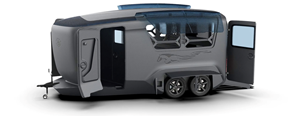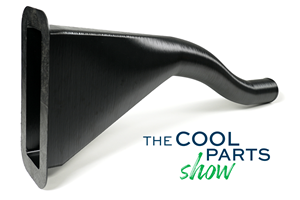BMW Group Vehicle to Adopt 3D Printed Center Console
A vehicle coming to market in 2027 will include a center console carrier manufactured through polymer robot-based large-format additive manufacturing (LFAM).
Share
The winning center console carrier was on display at Formnext 2024 in the Hans Weber booth, alongside a live 3D printing demo. The 3D printed part weighs about 4 kg and measures 300 × 300 × 1,000 mm.
In June 2024, the SPE Central Europe AutomotiveAward honored a 3D printed component for the first time in its history. The year’s grand award winner was a center console carrier created for a BMW Group vehicle, which is headed for production in 2027. The console is one of the largest 3D printed polymer components to be used in a commercial automobile to date, and stands to significantly reduce both the manufacturing complexity and carbon footprint of the overall vehicle.
The 3D printed version of the center console consolidates seven parts from the conventional assembly down to just one part produced through large-format additive manufacturing (LFAM). Rather than rely on injection molding (requiring a large, expensive tool) for the main body of the console and subsequent assembly work of parts from various suppliers, BMW can produce these new consoles in one piece with robot-based 3D printers supplied by the additive division of Hans Weber Maschinenfabrik. Each console can be 3D printed in about 3 hours and 40 minutes on the latter’s DXR platform MEX or LSP systems equipped with a single-screw Weber AE 20 extruder; only minimal machining is required before the component can be finished and installed.
Hans Weber demonstrated 3D printing of this component during Formnext 2024, using its own extruder technology coupled with an industrial robot.
Notably, the design integrates two air ducts that would otherwise need to be manufactured separately through a tooling-based molding process. 3D printing enabled integrating these air ducts in a more ideal route through the console, while also reducing overall manufacturing and assembly operations.

The conventional center console carrier (foreground) is seven components and incorporates multiple molded and sheet metal fabricated pieces. The 3D printed version is just one 3D printed piece, including the air ducts. Source: Hans Weber Maschinenfabrik GmbH
About 18,000 3D printed center console carriers will be needed annually. In production, the components will be 3D printed in-house by BMW, using Hans Weber robotic 3D printers and Akromid PA11 material from Akro-Plastic. Unlike smaller fused filament fabrication (FFF) 3D printers, Hans Weber’s large-scale DXR printers operate through fused granulate fabrication (FGF) or “direct extrusion” which enables 3D printing with readily available pellet materials, the same as those used in many molding processes, as opposed to filaments or powders created specially for additive. The Akromid material contains 40% recycled carbon fiber and renewable raw materials.
The material choice and design help to reduce the weight of the center console by 30% compared to the assembled version, which will enable better energy efficiency. The combination of recycled and renewable material, reduced weight, and overall optimization represented by the center console has resulted in a savings of about 70 kg of carbon for the entire vehicle.

The 3D printed center console with finishing touches; about 18,000 of these components will be 3D printed per year for BMW Group’s small-run vehicle. Source: Hans Weber Maschinenfabrik GmbH
Related Content
Robot Vs. Gantry for Large-Format Additive Manufacturing (Includes Video)
Additive Engineering Solutions, specialist at 3D printing very large parts and tools on gantry machines, now also uses a robot for large-format AM. Here is how the robot compares.
Read MoreNext-Gen Horse Trailers to Be Built With Robotic 3D Printing
Double D Trailers is currently developing a prototype horse trailer that will be made with large-format additive manufacturing. The technology brings potential benefits for labor, weight and design features to this subset of recreational vehicles.
Read MoreAircraft Ducts 3D Printed in Composite Instead of Metal: The Cool Parts Show #68
Eaton’s new reinforced PEKK, tailored to aircraft applications, provides a cheaper and faster way to make ducts compared to formed aluminum.
Read More8 Cool Parts From Formnext 2023: The Cool Parts Show #65
New additive manufacturing technologies on display at Formnext were in many cases producing notable end-use components. Here are some of the coolest parts we found at this year’s show.
Read MoreRead Next
BMW Expands Use of Additive Manufacturing to Foster Production Innovations
The BMW Group is manufacturing many work aids and tools for its own production system using various 3D printing processes, with items such as tailor-made orthoses for employees, teaching and production aids, and large, weight-optimized robot grippers, which are used for such things as carbon fiber-reinforced polymer roofs and entire floor assemblies.
Read More8 Cool Parts From Formnext 2024: The Cool Parts Show #78
End-use parts found at Formnext this year address various aspects of additive's advance, notably AM winning on cost against established processes.
Read More3D Printed Polymer EOAT Increases Safety of Cobots
Contract manufacturer Anubis 3D applies polymer 3D printing processes to manufacture cobot tooling that is lightweight, smooth and safer for human interaction.
Read More.jpg;width=70;height=70;mode=crop)












